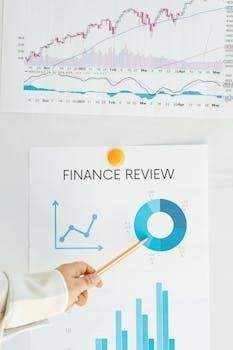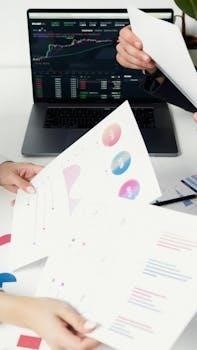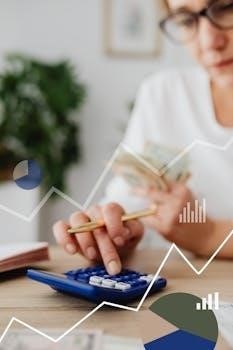Overview of Applied Statistics in Business and Economics
In today’s dynamic business world‚ applied statistics is essential for effective decision-making‚ providing real meaning through data-driven insights. It uses real-world business cases and data to illustrate statistical concepts‚ promoting understanding of why rather than just how.
The Role of Statistics in Business Decisions
Statistics plays a crucial role in business decisions by providing a framework for analyzing data and drawing meaningful conclusions. It empowers businesses to move beyond guesswork and make informed decisions based on concrete evidence. Statistical methods enable businesses to understand market trends‚ identify customer preferences‚ and assess the effectiveness of various strategies. From forecasting sales to optimizing resource allocation‚ statistics helps in reducing uncertainty and enhancing efficiency. By employing statistical analysis‚ companies can evaluate the performance of their operations‚ identify areas for improvement‚ and track progress towards goals. Furthermore‚ statistical thinking encourages a data-driven culture‚ where decisions are based on facts rather than assumptions. This allows for a more objective and strategic approach to business management. In essence‚ statistics provides the tools necessary to turn raw data into actionable intelligence‚ leading to better outcomes and competitive advantages in the marketplace. The emphasis is on thinking about data‚ choosing appropriate analytic tools‚ using computers effectively‚ and recognizing the limitations of statistical methods.

Core Concepts in Applied Statistics
Understanding descriptive statistics‚ data visualization‚ probability‚ and probability distributions is fundamental. These concepts form the basis for statistical analysis‚ enabling businesses to interpret data effectively and make informed decisions.
Descriptive Statistics and Data Visualization
Descriptive statistics involves summarizing and presenting data in a meaningful way. Key measures include central tendency (mean‚ median‚ mode)‚ dispersion (variance‚ standard deviation)‚ and shape (skewness‚ kurtosis). These measures help to understand the characteristics of a dataset‚ providing an overview of the data’s distribution and variability. Data visualization‚ on the other hand‚ enhances understanding through graphical representations. Techniques like histograms‚ scatter plots‚ and box plots allow for the visual exploration of data patterns and relationships. Effective use of both descriptive statistics and data visualization enables businesses to identify trends‚ outliers‚ and key insights‚ facilitating better decision-making. Visualizations make complex data understandable and accessible to a wider audience‚ aiding in communication and analysis. These tools are crucial in the initial stages of statistical analysis‚ providing a foundation for more advanced techniques. This combination helps to explore and understand the underlying data before making inferences.
Probability and Probability Distributions
Probability is fundamental to understanding statistical inference‚ quantifying the likelihood of events occurring. It provides a framework to assess uncertainty and risk‚ crucial in business and economics. Probability distributions‚ both discrete and continuous‚ describe the probabilities of different outcomes. Discrete distributions‚ such as the binomial and Poisson‚ deal with countable outcomes‚ while continuous distributions‚ including the normal and exponential‚ handle measurements on a continuous scale. These distributions allow for the modeling of various business phenomena‚ from customer arrival rates to stock price fluctuations. Understanding these distributions helps to make predictions and calculate the chances of success or failure. The normal distribution‚ particularly‚ is widely used due to its properties and the central limit theorem. These tools enable businesses to make informed decisions by assessing the likelihood of different scenarios and outcomes. They provide the foundation for understanding statistical inference and hypothesis testing.

Statistical Methods and Applications
Statistical methods are the core of analyzing data for informed business decisions. They include sampling‚ hypothesis testing‚ and regression‚ with applications ranging from market research to forecasting and quality control‚ all based on real-world data.
Sampling and Sampling Distributions
Sampling is a core concept in statistics‚ particularly when analyzing large datasets in business and economics. Instead of examining an entire population‚ we study a smaller subset‚ or a sample‚ to draw inferences about the whole. Understanding how samples are selected and how they can vary is crucial. This leads us to sampling distributions‚ which describe the distribution of a statistic across multiple samples from the same population. This concept is essential for understanding the degree to which a sample result might differ from the actual population value. The principles of sampling ensure that the data collected is representative‚ and that statistical conclusions are valid. The choice of sampling method influences the accuracy and reliability of our statistical findings. Careful consideration of sampling techniques allows for efficient and effective data analysis‚ while allowing insights into a larger demographic or market.
Hypothesis Testing and Statistical Inference
Hypothesis testing and statistical inference are fundamental tools for drawing meaningful conclusions from data in business and economics. Hypothesis testing involves making assumptions about the population‚ formulating a null and alternative hypothesis‚ and then using sample data to determine if there is sufficient evidence to reject the null hypothesis. It’s a systematic way of deciding whether the observed data supports a specific claim or theory. Statistical inference‚ on the other hand‚ uses sample data to make generalizations about the population. It allows us to estimate population parameters‚ such as means or proportions‚ and to assess the uncertainty associated with these estimates. These methods are crucial for evaluating the effectiveness of business strategies‚ comparing different marketing approaches‚ and understanding economic trends. These methods are essential for making informed‚ data-backed decisions.

Practical Implementation and Tools
Effective application of statistical methods requires proficiency in using various tools. Excel remains a fundamental tool‚ while specialized software offers advanced capabilities for data analysis‚ enabling informed decisions in business and economics.
Use of Excel in Statistical Analysis
Excel stands as a cornerstone for statistical analysis in business and economics due to its accessibility and versatility. It provides a user-friendly interface for performing various statistical calculations‚ from basic descriptive statistics to more complex analyses. The software facilitates data organization‚ cleaning‚ and transformation‚ enabling users to prepare data for analysis efficiently. Its built-in functions‚ such as AVERAGE‚ STDEV‚ and CORREL‚ allow for quick calculations of key statistical measures. Furthermore‚ Excel’s charting capabilities enable effective data visualization‚ helping to identify trends and patterns. It can also handle many statistical tests. Excel integrates well with other software and platforms‚ making it easy to share data and results across teams and departments. It is often the first tool for those learning statistics‚ and its widespread use ensures that most professionals are comfortable using it. The software’s continuous updates also mean that it remains relevant for modern data analysis needs.
Software and Technology for Data Analysis
Beyond Excel‚ a variety of specialized software and technologies are used in applied statistics for business and economics. Statistical packages like SPSS and SAS offer advanced analytical capabilities‚ including sophisticated modeling and data manipulation. Programming languages such as R and Python are increasingly popular for their flexibility and power in handling complex data sets and analyses. These tools enable users to perform customized statistical procedures‚ develop predictive models‚ and automate repetitive tasks. Cloud-based platforms provide scalable resources and collaborative environments for data analysis. Data visualization tools like Tableau and Power BI transform raw data into interactive dashboards‚ enabling clear communication of results. The integration of AI and machine learning is expanding the scope of statistical analysis‚ enabling predictive analysis‚ and pattern recognition. Access to such software and technology is crucial for businesses seeking a competitive edge through data-driven decisions.

Textbooks and Resources
Numerous textbooks and resources support learning applied statistics in business and economics. “Applied Statistics in Business and Economics” by Doane and Seward‚ available in multiple editions‚ is a popular choice‚ emphasizing real-world applications. Many textbooks offer accompanying online resources‚ including practice problems‚ datasets‚ and software tutorials; Websites and online platforms provide access to statistical datasets‚ research articles‚ and interactive learning modules. Free ebooks and PDFs offer alternative learning options. Educational materials often integrate case studies and examples directly from business settings‚ illustrating the practical relevance of statistical techniques. Access to statistical software packages through educational licenses allows students to develop hands-on experience. These resources collectively provide a wide range of materials for students and professionals seeking to deepen their understanding of applied statistics. Utilizing varied resources aids in comprehensive learning and skill development in this vital field.

